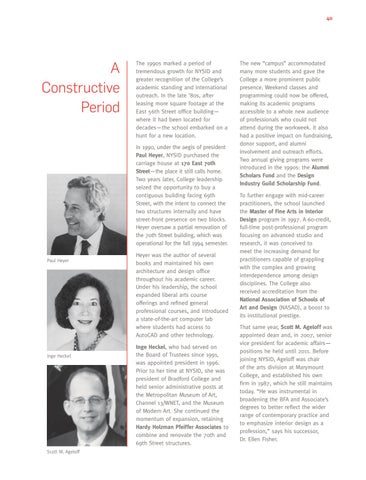40
A Constructive Period
The 1990s marked a period of tremendous growth for NYSID and greater recognition of the College’s academic standing and international outreach. In the late ’80s, after leasing more square footage at the East 56th Street office building— where it had been located for decades—the school embarked on a hunt for a new location. In 1990, under the aegis of president Paul Heyer, NYSID purchased the carriage house at 170 East 70th Street—the place it still calls home. Two years later, College leadership seized the opportunity to buy a contiguous building facing 69th Street, with the intent to connect the two structures internally and have street-front presence on two blocks. Heyer oversaw a partial renovation of the 70th Street building, which was operational for the fall 1994 semester.
Paul Heyer
Inge Heckel
Scott M. Ageloff
Heyer was the author of several books and maintained his own architecture and design office throughout his academic career. Under his leadership, the school expanded liberal arts course offerings and refined general professional courses, and introduced a state-of-the-art computer lab where students had access to AutoCAD and other technology. Inge Heckel, who had served on the Board of Trustees since 1991, was appointed president in 1996. Prior to her time at NYSID, she was president of Bradford College and held senior administrative posts at the Metropolitan Museum of Art, Channel 13/WNET, and the Museum of Modern Art. She continued the momentum of expansion, retaining Hardy Holzman Pfeiffer Associates to combine and renovate the 70th and 69th Street structures.
The new “campus” accommodated many more students and gave the College a more prominent public presence. Weekend classes and programming could now be offered, making its academic programs accessible to a whole new audience of professionals who could not attend during the workweek. It also had a positive impact on fundraising, donor support, and alumni involvement and outreach efforts. Two annual giving programs were introduced in the 1990s: the Alumni Scholars Fund and the Design Industry Guild Scholarship Fund. To further engage with mid-career practitioners, the school launched the Master of Fine Arts in Interior Design program in 1997. A 60-credit, full-time post-professional program focusing on advanced studio and research, it was conceived to meet the increasing demand for practitioners capable of grappling with the complex and growing interdependence among design disciplines. The College also received accreditation from the National Association of Schools of Art and Design (NASAD), a boost to its institutional prestige. That same year, Scott M. Ageloff was appointed dean and, in 2007, senior vice president for academic affairs— positions he held until 2011. Before joining NYSID, Ageloff was chair of the arts division at Marymount College, and established his own firm in 1987, which he still maintains today. “He was instrumental in broadening the BFA and Associate’s degrees to better reflect the wider range of contemporary practice and to emphasize interior design as a profession,” says his successor, Dr. Ellen Fisher.
